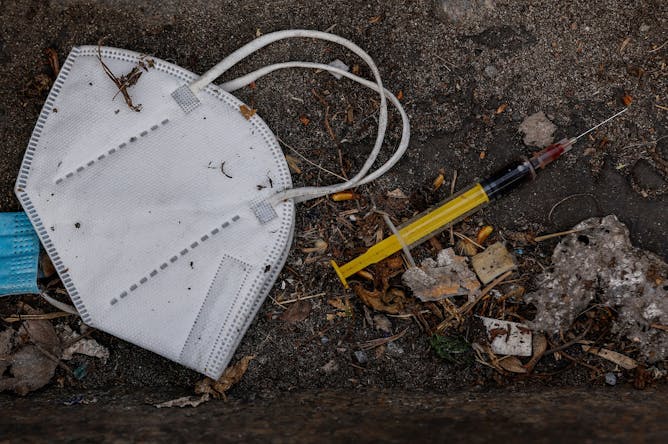|
When the pandemic hit, the U.S. was already in the grips of another epidemic. Opioids had been killing Americans at an astonishing rate, driven by fentanyl – a deadly synthesized drug that is mixed with heroin or sold as heroin. Its potency makes it easy to overdose.
As bad as the opioid epidemic was before COVID-19, it has only gotten worse. New figures from the CDC show that in the year through April 2021, more than 100,000 people in the U.S. died of drug overdoses, up almost a third from the previous 12-month period.
Brandeis’ Andrew Kolodny, who has been fighting the epidemic for 20 years as a public health official and clinician, explains why.
Also today:
|

|
Matt Williams
Breaking News Editor
|
|

Emblems of America’s epidemics.
David Gannon/AFP via Getty Images
Andrew Kolodny, Brandeis University
The number of fatal drug overdoses in the US over a 12-month period has surpassed 100,000 for the first time. Fentanyl is the main driver of the spike in deaths.
|
Politics + Society
|
-
Jane E Kirtley, University of Minnesota
The mainstream media are holding their collective noses and supporting Project Veritas after its founder’s home was raided by the FBI. It’s a matter of principle and self-preservation.
-
Ronald Sullivan, Harvard Law School
In its decision, the Wisconsin jury believed Kyle Rittenhouse acted in self-defense – not recklessness, as prosecutors alleged – when he shot three people, two fatally.
-
Andrea Ross, University of California, Davis
Adopted children face a slew of legal challenges in trying to obtain their original birth certificates. Lawmakers across the country are increasingly granting more access as a basic human right.
|
|
Science + Technology
|
-
Gregory Porumbescu, Rutgers University - Newark
Smart cities’ focus on technology has made the digital divide worse, not better. The new infrastructure law could change that.
|
|
Economy + Business
|
-
Veronika Dolar, SUNY Old Westbury
Biden is expected to soon decide whether to keep Jerome Powell as Federal Reserve chair or name a replacement. The nominee will have more influence on the trajectory of inflation than anyone else.
|
|
Environment + Energy
|
-
Janet K. Swim, Penn State; Nathaniel Geiger, Indiana University
A set of studies found people prefer incentives to disincentives, especially for individuals but also for businesses. They have views on clean energy and efficiency, too.
-
Thomas Durant Visser, University of Vermont
Barns are practical buildings, designed to safeguard farm animals and equipment. Why are so many of them painted to stand out from the landscape?
|
|
Arts + Culture
|
-
Peter C. Mancall, USC Dornsife College of Letters, Arts and Sciences
The communion between Native Americans and the Pilgrims makes for a compelling narrative. But it masks the suspicions and brewing violence that were far more representative of the era.
-
Jack Lynch, Rutgers University - Newark
From ‘turkey trot’ to ‘going cold turkey,’ the centerpiece to many Thanksgiving dinners has lent its name to many things. But it also borrowed its name from elsewhere.
|
|
Trending on Site
|
-
Patrick Jackson, University of Virginia
Merck and Pfizer both have oral antiviral pills under review by the FDA. Such treatments could help turn the tide of the pandemic.
-
Robert Jacobs, University of Rochester
Errors don’t necessarily mean your mind is faulty. They may actually be a sign of a cognitive system with limited capacity working efficiently.
-
Nathaniel Hafer, UMass Chan Medical School
The two types of COVID-19 tests – antigen and PCR – work in very different ways, which is why one is fast but less accurate and the other is slow and precise.
|
|
Reader Comments 💬
|
-
"I’m also wondering how much the tech sector plays into this. Suddenly, everyone was work from home. That meant you could get a job from ANY tech company without having to move from where you lived. I’ve seen it happen in my own job place. Many of us moved closer to home/family/relatives, and were able to keep our job. Many also found new work at west coast tech companies that would have required moving pre-pandemic."
– Reader Margaret Schultz on the story The ‘great resignation’ is a trend that began before the pandemic – and bosses need to get used to it
|
|
| |
| |
| |
| |
|
|